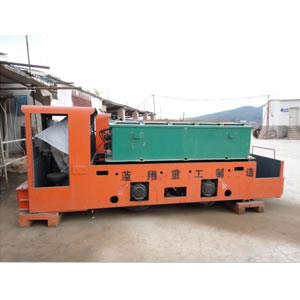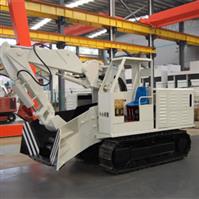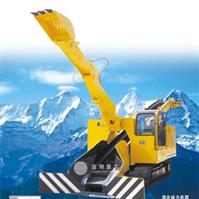Product List
- Loading, Excavating, Drilling and Bolting Machine
- Single Boom Loading, Excavating, Drilling and Bolting Machine
- Double Boom Loading, Excavating, Drilling and Bolting Machine
- Rock Drilling Equipment
- Double Boom Jumbo
- Single Boom Jumbo
- Tire-type Single-boom Drill Jumbo
- Road Header
- Side Dumping Rock Loader
- Mucking Loader
- Crawler Mucking Loader
- Rail Wheel Mucking Loader
- Wheel Mucking Loader
- Mine Car
- Shutter Mine Car (ST Series)
- Lap Shutter Mine Car (SD Series)
- Side Dump Wagon (KZ Series)
- Mine Side Dump Wagon (MCC Series)
- Other Equipment
- Mining Skip
- Mobile Belt Conveyor
- Battery Locomotive
- Rail Line Concrete Mixing Truck
Battery Locomotive
Description
1. Our battery locomotive is used for mining and tunneling applications. It is explosion-proof, which ensures the safety of crews.
2. Battery-powered locomotive is applicable to methane mine tunnel and marsh gas tunnel for transporting coal, waste rock, equipment and people.
3. Three types of battery locomotives are available: regular locomotive, underground explosion-proof locomotive and locomotive for outdoor project.
Components
1. Mechanical parts: chassis, traveling mechanism, braking mechanism, sand spraying mechanism, driver's chamber, etc.
2. Electrical parts: electronic speed control, bow collector, etc.
Advantages
1. Large traction force, high speed, strong carrying capacity, and safe and reliable to operate.
2. Humanized design.
(1) Broad view of driver’s chamber.
(2) Enough space for assembly and disassembly.
3. Battery.
(1) High performance.
(2) Durable.
(3) Cheap operating fee.
(4) Recyclable and does no harm to environment.
4. Accessories with excellent performance.
(1) Indicator shows over-voltage and under-voltage automatically.
(2) Air damping.
(3) Electric braking.
(4) Mechanical braking.
5. No risk of explosion by spark, which is suitable for gas mine.
6. No need of setting line by using battery locomotive, which is especially suitable for tunnel mucking transportation and small-capacity transporting system with irregular tunnels.
Working Environment
1. Altitude above sea level of using battery locomotive: lower than 1200m.
2. Environment temperature: -20℃ to 40℃.
3. Humidity: maximum average relative humidity of the most humid month is 95%. (The mean minimum temperature of the month should not higher than 25℃.)
4. There is no gas or conductive dust in the air that may corrode metal and cause damage.
Working Principle
1. Direct current provided by battery goes into the electric motor by passing through the explosion-proof plug, control and resistance box to drive the electric motor.
2. By driving gear, the electric motor makes the wheel roll and the traction engine move forward.
Maintenance
1. Check the locomotive each shift, and solve any problem immediately.
2. Regular maintenance
(1) Check each week.
① Thorough check at least once.
② Check fasteners thoroughly.
③ Check electric parts and the electric system.
2. Minor maintenance monthly.
3. Medium maintenance every three months or half a year.
Speed Reducing System and Maintenance
1. Lubricating oil of the speed reducer box.
Check the volume each week and add oil according to the consumption amount.
2. Gear engagement
(1) If hear any abnormal sound when the battery locomotive is running, it indicates the gear mounting is loosen or the gear engagement clearance has changed or worn off.
(2) Severe wear-off may also be caused by lacking oil or could also be caused by oil lacking and impure oil.
(3) Maintenance: ① adjust the gear engagement clearance and contacting areas; (2) add oil; (3) replace gear and clean oil tank.
3. Check the wheel every month
(1) Regularly check the wear-off of the wheel
① When the wheel dent goes beyond 3 mm in depth and 5 mm in length, or has worn off more 5 mm, dismantle the wheel and polish it before using it again.
② Replace the tyre if the wear-off depth goes beyond 25 mm.
③ When repairing the wheel by turning, the diameter deviation of the two wheels of a battery locomotive should not larger than 2 mm.
1. Our battery locomotive is used for mining and tunneling applications. It is explosion-proof, which ensures the safety of crews.
2. Battery-powered locomotive is applicable to methane mine tunnel and marsh gas tunnel for transporting coal, waste rock, equipment and people.
3. Three types of battery locomotives are available: regular locomotive, underground explosion-proof locomotive and locomotive for outdoor project.
Components
1. Mechanical parts: chassis, traveling mechanism, braking mechanism, sand spraying mechanism, driver's chamber, etc.
2. Electrical parts: electronic speed control, bow collector, etc.
Advantages
1. Large traction force, high speed, strong carrying capacity, and safe and reliable to operate.
2. Humanized design.
(1) Broad view of driver’s chamber.
(2) Enough space for assembly and disassembly.
3. Battery.
(1) High performance.
(2) Durable.
(3) Cheap operating fee.
(4) Recyclable and does no harm to environment.
4. Accessories with excellent performance.
(1) Indicator shows over-voltage and under-voltage automatically.
(2) Air damping.
(3) Electric braking.
(4) Mechanical braking.
5. No risk of explosion by spark, which is suitable for gas mine.
6. No need of setting line by using battery locomotive, which is especially suitable for tunnel mucking transportation and small-capacity transporting system with irregular tunnels.
Working Environment
1. Altitude above sea level of using battery locomotive: lower than 1200m.
2. Environment temperature: -20℃ to 40℃.
3. Humidity: maximum average relative humidity of the most humid month is 95%. (The mean minimum temperature of the month should not higher than 25℃.)
4. There is no gas or conductive dust in the air that may corrode metal and cause damage.
Working Principle
1. Direct current provided by battery goes into the electric motor by passing through the explosion-proof plug, control and resistance box to drive the electric motor.
2. By driving gear, the electric motor makes the wheel roll and the traction engine move forward.
Maintenance
1. Check the locomotive each shift, and solve any problem immediately.
2. Regular maintenance
(1) Check each week.
① Thorough check at least once.
② Check fasteners thoroughly.
③ Check electric parts and the electric system.
2. Minor maintenance monthly.
3. Medium maintenance every three months or half a year.
Speed Reducing System and Maintenance
1. Lubricating oil of the speed reducer box.
Check the volume each week and add oil according to the consumption amount.
2. Gear engagement
(1) If hear any abnormal sound when the battery locomotive is running, it indicates the gear mounting is loosen or the gear engagement clearance has changed or worn off.
(2) Severe wear-off may also be caused by lacking oil or could also be caused by oil lacking and impure oil.
(3) Maintenance: ① adjust the gear engagement clearance and contacting areas; (2) add oil; (3) replace gear and clean oil tank.
3. Check the wheel every month
(1) Regularly check the wear-off of the wheel
① When the wheel dent goes beyond 3 mm in depth and 5 mm in length, or has worn off more 5 mm, dismantle the wheel and polish it before using it again.
② Replace the tyre if the wear-off depth goes beyond 25 mm.
③ When repairing the wheel by turning, the diameter deviation of the two wheels of a battery locomotive should not larger than 2 mm.
Parameter
| Item | Model | ||||
|
XK5-6.7. 9/90-A |
XK8-6/ 110-A |
XK8-7.9/ 132-A |
XK8-6.7. 9/144-A |
XK12-6.7. 9/192-A |
|
| Net Weight (T) | 5 | 8 | 8 | 8 | 12 |
| Track Gauge (mm) | 600/762/900 | 600 | 762/900 | 600/762/900 | 600/762/900 |
| Traction (KN) | 7.06 | 11.8 | 11.18 | 12.83 | 16.48 |
| Speed (km/h) | 7 | 6.2 | 7.5 | 7.8 | 8.7 |
| Max. Traction (KN) | 12.26 | 19.62 | 19.62 | 19.62 | 29.43 |
| Norminal Voltage of Battery (V) | 90 | 110 | 132 | 144 | 192 |
| Battery Capacity (Ah) | 330 | 370 | 370 | 440 | 560 |
| Traction Motor Power × Number of Motor (kW) | 7.5×2 | 11×2 | 11×2 | 15×2 | 22×2 |
| Overall Length (mm) | 2960 | 4430 | 4430 | 4470 | 4740 |
| Overall Dimension (mm) | 996 × 1105 × 243 | 1054 | 1354 | 1050/1212/1350 | 1600 |
| Distance from Track Surface to Ceiling (mm) | 1550 | 1550 | 1550 | 1600 | 1600 |
| Traction (mm) | 210/320 | 320/430 | 320/430 | 320/430 | 320/430 |
| Axle Gauge (mm) | 850 | 1100 | 1100 | 1150 | 1220 |
| Wheel Gauge (mm) | φ520 | φ680 | φ680 | φ680 | φ680 |
| Min. Curve Radius (m) | 6 | 7 | 7 | 7 | 7 |
| Speed Control Method | Resistance | Resistance | Resistance | Resistance | Resistance |
| Braking Method | Mechanical | Mechanical | Mechanical | Mechanical | Mechanical, electric, air dumping |
| Note | 1st level transmission | 1st level transmission | Battery in parallel, 2nd level transmission | ||
 English
English Русский
Русский Español
Español Français
Français Português
Português العربية
العربية




